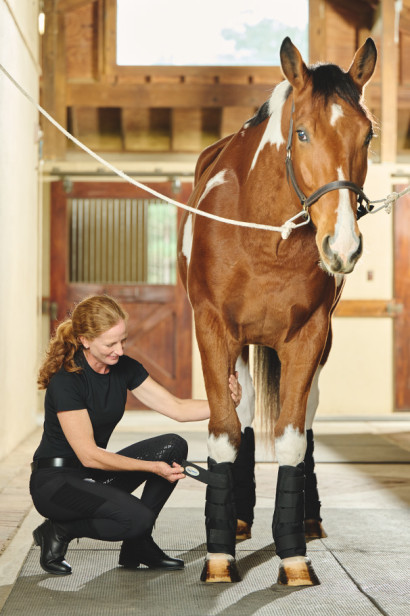Equine Therapy for Children: Emotional and Behavioral Assistance Clarified
Equine Therapy for Children: Emotional and Behavioral Assistance Clarified
Blog Article
Evaluating the Efficiency of Laser Treatment in Horse Treatment for Injury Recovery
The evaluation of laser treatment's performance in equine injury recovery rests on numerous factors, including recuperation time, pain reduction, and tissue regrowth. Clinical researches suggest significant improvements in conditions like tendonitis and osteoarthritis, credited to boosted mobile function and raised ATP production. Vets frequently observe remarkable end results with laser treatment compared to traditional methods, positioning it as a critical aspect in equine care. The requirement for continuous tracking and customized therapy plans can not be overemphasized. What certain clinical evidence sustains these cases, and just how do vets execute these methods in method?
Comprehending Laser Treatment
Laser therapy has actually ended up being a pivotal device in veterinary medication, particularly in the therapy of equine conditions. Known for its non-invasive nature and efficiency, laser therapy entails the application of details wavelengths of light to boost tissue fixing and decrease inflammation. This therapeutic modality is significantly preferred for its ability to increase the healing process in horses struggling with a variety of musculoskeletal injuries and chronic problems.
The main mechanism behind laser therapy is its capacity to boost cellular features. When laser light permeates the skin, it is taken in by mitochondria, the powerhouse of cells, which causes enhanced production of adenosine triphosphate (ATP) This biochemical power increase assists in mobile repair service and regeneration. Furthermore, laser therapy advertises vasodilation, boosting blood flow and oxygen delivery to broken tissues, thus speeding up recuperation.
In equine medication, laser therapy is particularly valuable for problems such as tendonitis, osteoarthritis, and wound healing. The technique is lauded for its pain-relieving residential or commercial properties, enabling horses to restore flexibility and function a lot more swiftly. Veterinarians likewise value its marginal negative effects contrasted to various other therapy methods, making it a reliable and secure choice for equine treatment.

How Laser Treatment Functions

Upon absorption, these photons trigger a series of biochemical modifications, improving mitochondrial feature and causing boosted adenosine triphosphate (ATP) production. This rise in ATP speeds up cellular metabolic process, promoting tissue repair and regeneration. In addition, laser therapy modulates inflammatory feedbacks by influencing cytokine levels and lowering oxidative tension, consequently reducing pain and swelling.
One more considerable aspect of laser therapy is its duty in boosting microcirculation. The therapy promotes vasodilation, enhancing blood flow and oxygen distribution to broken cells (Equine Therapy). This facilitates the removal of mobile particles and supports the expansion of fibroblasts and collagen synthesis, vital for wound recovery
Clinical Evidence
The efficiency of laser therapy in equine therapy has been confirmed via different clinical visit this site right here research studies, showcasing its healing prospective throughout a range of problems. Numerous controlled trials and empirical researches have documented considerable enhancements in cells repair work, pain decrease, and general rehabilitation timelines. A research carried out by Turner et al. (2012) demonstrated that horses treated with low-level laser therapy (LLLT) for tendon injuries displayed accelerated healing contrasted to those obtaining standard therapies. The study highlighted a significant decrease in inflammation and enhanced collagen formation.
Likewise, study by Johnson and coworkers (2015) concentrated on equine muscular tissue injuries, revealing that laser treatment considerably accelerated muscle mass fiber regeneration and lowered muscle mass stiffness. These searchings for were proven by histological analyses showing enhanced muscle cells organization. Clinical evaluations have actually shown that laser therapy can ease chronic conditions such as osteoarthritis. A research by Smith et al. (2018) reported that equines with osteoarthritic joints experienced noteworthy discomfort alleviation and raised series of motion complying with a routine of laser therapy sessions.
Veterinarian Insights

Vets also appreciate the convenience of laser treatment. She directs out that laser therapy can be tailored to the specific needs of each horse, guaranteeing ideal outcomes.
Moreover, vets value the capability to incorporate laser therapy with various other treatment modalities. This multimodal method can improve general treatment effectiveness, providing a detailed solution for equine rehab. Such recommendations from experienced specialists underscore the growing acceptance and application of laser therapy in equine medication.
Practical Considerations
A vital element of implementing laser therapy in equine therapy entails comprehending the practical considerations that guarantee its efficiency and safety and security. It is critical to choose the ideal laser device, as numerous types vary in wavelength, power, and infiltration deepness. Veterinarians should be fluent in these specifications to customize therapy procedures effectively to every injury kind
Additionally, the regularity and period of laser therapy sessions require mindful planning to make the most of therapeutic benefits while decreasing any kind of prospective damaging effects. Regular tracking of the horse's response to therapy can assist needed changes in the treatment program. Establishing a important source risk-free and controlled setting during treatments is likewise vital to protect against unintentional exposure to laser discharges, which could hurt both the equine and the trainer.
Training and certification of employees carrying out check here laser therapy are critical to ensure proper strategy and to copyright safety criteria. In addition, preserving exact records of each session, including laser setups and observed results, is important for assessing the general efficiency of the treatment and for making data-driven choices.
Verdict
Laser treatment has actually become an efficient technique in equine injury rehab, offering significant benefits in recuperation time, pain relief, and cells healing. Scientific researches emphasize substantial renovations in conditions such as tendonitis and osteo arthritis, associated to improved cellular function and increased ATP manufacturing. Veterinarian monitorings corroborate these findings, highlighting premium results contrasted to standard treatments. For optimal outcomes, continual surveillance and individualized therapy methods continue to be crucial in leveraging the full possibility of laser therapy in equine treatment.
Report this page